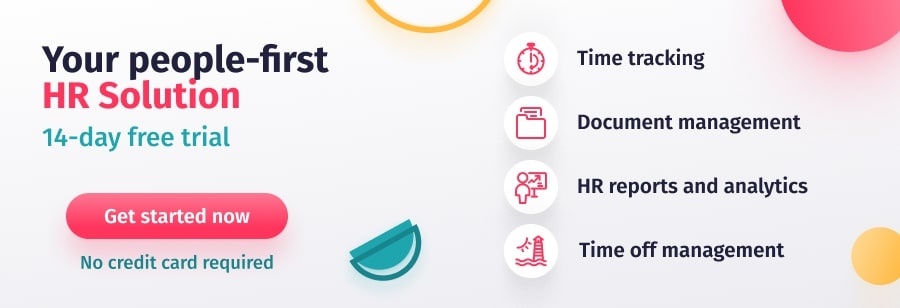The onboarding experience that new hires have at your company can have a huge impact on whether or not they choose to remain at your company. In fact, when done well, new hires are 77% more likely to integrate and hit performance goals and 25% more likely to become loyal, long-term employees. This makes it more important than ever to track your onboarding metrics to make sure you are setting your new hires up for success.
In this post, we will take a look at the importance of implementing a positive and effective onboarding process in your company. We will also discuss how to track onboarding success and what crucial new employee onboarding metrics you should be monitoring on a regular basis.

What is Onboarding?
Let’s start with the basics: what is onboarding?
Your employee onboarding process has a huge impact on your business. It is where new hires form their first impression of your company, and where many candidates decide whether or not they will remain at your company. Preboarding and onboarding help you welcome a new employee to the company so that they can seamlessly integrate into your culture and understand your goals, vision and mission as a company. This helps you transform new employees into confident, engaged, and empowered team members.
The average onboarding time will vary depending on your business. However long it is, you need to make sure your office or digital onboarding process covers a number of key areas. Firstly, it’s an opportunity to ensure all onboarding documents are completed by new hires so that you have all the vital information you need. For example, if you work in manufacturing, you can share information about Good Manufacturing Practices in advance so that new hires can begin familiarizing themselves with materials and equipment.
Aside from paperwork, you should also include a range of creative new employee onboarding activities to make the process as fun and interactive as possible. This will help new hires understand your culture and build connections with their new colleagues. You also need to make sure there is a clear distinction between onboarding vs. orientation so that they know what to expect on their first day.
If you don’t already have one, you should create an onboarding checklist to make sure all the above is covered during this vital introductory phase. HR onboarding software is also a highly effective solution for making sure you get the most from the process.
What are Onboarding Metrics?
Once you’re sure that your office or remote onboarding process takes into account all vital elements, you need to make sure it’s having a positive impact on your business as a whole. This is where onboarding metrics come in.
Onboarding metrics help you analyze and monitor the impact of your onboarding experience on your business. For example, you can evaluate how your onboarding process is affecting the employee experience, retention and time to productivity. In other words, if your onboarding experience is helping you convert new hires into happy and productive members of staff. By analyzing these key new employee metrics you can identify what works well, and what areas you need to improve in order to set your new hires up for success from day one.
Onboarding Metrics to Track Onboarding Success
Before you decide how to track onboarding success, you need to think about what metrics you want to measure, and why. This will help you ensure the onboarding metrics you choose are aligned with your business goals and company culture.
For example, if your end goal is to increase retention levels, then you can focus on metrics for employee turnover and satisfaction. If you want to decrease new hire time to productivity, then you can focus on performance metrics. Ideally, you should track as many key areas as possible. Clarifying your priorities will help you focus on the metrics that have the biggest impact on your business.
Measuring the Effectiveness of Onboarding Metrics
Once you’ve determined what your HR benchmarking goals are, you need to implement a system for regularly tracking your new employee onboarding metrics. The more regularly you monitor your HR KPIs, the better understanding you will have about what processes are working well. Plus, the more data you have, the easier it will be to spot any negative trends.
The best way to ensure you have access to all the data you need is by using an HR dashboard to track your key onboarding metrics. You can do this with HR Software, such as predictive analytics software for HR. This provides you with a centralized interface for tracking all your important onboarding KPIs. For example, you can use software to analyze responses to employee engagement questions. This will help you determine where there might be potential causes of high turnover rates.
5 Onboarding Metrics
We’ve looked at how to track onboarding success. Now let’s take a look at some of the key onboarding metrics you can use to measure how effective your onboarding program is. These onboarding metrics take into account the impact your onboarding experience has on employee happiness, engagement and satisfaction. You can also see how onboarding affects retention, productivity and turnover levels.
Employee Happiness & Engagement
When it comes to people analytics, one of the most important onboarding metrics you can track relates to employee happiness and engagement. This is because if a new hire is not happy and engaged, they are less likely to remain at your company.
The best way to monitor this is by conducting regular check-ins with your new hires. You can do this by conducting a new hire onboarding survey. You could also use employee Net Promoter Scores (eNPS) to determine if new hires would recommend your company to others.
New Employee Satisfaction
This is slightly different to employee happiness, which relates more to an employee’s emotional state. Employee satisfaction is all about how new hires perceive their working conditions and environment, benefits, and compensation, amongst other factors.
Regular questionnaires and surveys are also great tools to use for tracking this onboarding metric. Ask about job and workplace satisfaction and find out whether you are meeting new hire expectations. Would new hires recommend you as an employer? Ask employees to rate you on a scale of 1-10.
Voluntary and Involuntary Turnover
New hire turnover is perhaps one of the most indicative onboarding metrics. If a high rate of new employees is leaving soon after joining your company, then it suggests that something might be wrong with your onboarding process.
When it comes to new employee turnover, you need to make sure you distinguish between voluntary and involuntary turnover. This is important as each type can indicate different issues in your company:
- Voluntary turnover: measures the number of employees who leave the company of their own accord. High rates suggest there is a problem with your onboarding process or general employee experience.
- Involuntary turnover: measures the number of employees who are fired. High rates suggest there is a problem with your recruitment process. For example, you might not be finding the right candidates for the job.
If you identify an issue with your new employee turnover rate, you can then look into the causes of a high turnover rate.
Retention
On the flip side, you also need to track your retention and attrition rate. This measures how many new hires stay at your company for a defined period after onboarding. Generally speaking, you should focus on the first 18 months that new hires are with you. If an employee stays past that period, they are far more likely to remain with you.
Time to Productivity
Time to productivity can also give you a great deal of insight into the effectiveness of your onboarding process. This is the time it takes an employee to become a productive member of staff after joining your company.
Time-to-productivity metrics will vary between teams, seniority, and roles. However, you should still establish a general target that’s applied to all individuals. Ask your managers to identify at what point new hires are performing their roles with little or no supervision. This will help you get an accurate measure of this metric. You should also conduct regular check-ins to see how well new hires are performing.
Cost of New Hire Turnover
Perhaps the biggest impact of having a negative onboarding experience is the effect it has on new hire turnover. Studies have shown that approximately 20% of employees leave within their first 45 days of employment. And this comes at a cost in a number of ways.
Generally speaking, the average costs to replace an employee are:
- $1,500 for hourly employees
- 100 to 150% of an employee’s salary for technical positions
- Up to 213% of an employee’s salary for C-suite positions
Reducing new hire turnover can therefore help your company save thousands over the course of a typical year. It can also improve your employer brand and reputation. And one of the best ways to reduce new hire turnover is by providing them with a positive onboarding experience. That’s why it’s so important to understand the experience that new hires have by tracking your onboarding metrics. You can then identify what areas you need to improve in your onboarding process. This will help you set new employees up for success as engaged and empowered team members from day one.

